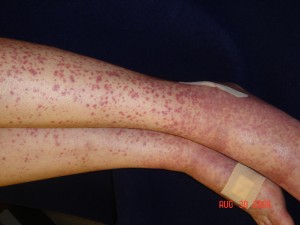Henoch-Schӧnlein Purpura
Last updated: June 18, 2015
Synonyms: Anaphylactoid purpura, allergic purpura.
ICD-9 Code: 287.0.
ICD-10 Code: D69.0
Definition: Henoch-Schönlein purpura is a systemic, small-vessel vasculopathy affecting the skin (lower extremities), gut, and kidneys. Henoch-Schönlein purpura is classically characterized by the triad of nonthrombocytopenic purpura, arthralgia, and abdominal pain.
Etiology: The cause of Henoch-Schönlein purpura is unknown; it is labeled as allergic because peak onset is in the spring, often after upper respiratory infection by viruses or streptococci. It is sometimes a consequence of therapy (e.g., ampicillin, penicillin, erythromycin, quinidine, quinine).
Pathology: Biopsies demonstrate leukocytoclastic vasculitis (venulitis) in the skin or GI tract. IgA deposition, found in 70% of skin and 90% of renal lesions, is diagnostic. Renal biopsy specimen may show mesangial hypercellularity and segmental necrotizing glomerulonephritis.
Demographics: Age at onset is bimodal. Most cases affect children, usually between 2 and 11 years of age. The mean age at onset is 43 years for adults (range, 30–70). Males are affected more than females.
Cardinal Findings: Onset is usually heralded by persistent or intermittent palpable purpura or petechiae involving the lower extremities and buttocks, sometimes with dependent edema. Lesions often progress from red to purple to brown. They may coalesce to form large ecchymoses. Fever is seen in 50% of patients, and musculoskeletal manifestations (arthralgia/arthritis of ankles or knees) are present in 75% of patients. Intestinal disease is more common in children and manifests as diarrhea, cramping, GI bleeding, hematemesis, melena, or, rarely, intussusception. IgA nephropathy is more common in adults than children. Renal insufficiency is typically brief but may develop in 3% to 15% of patients.
Uncommon Manifestations: Skin involvement of the face, upper extremities, or torso; ulcerative lesions; bleeding gums; bowel perforation; renal insufficiency; headache; neuropathy; seizures; orchitis; hemoptysis; and cardiac ar- rhythmias have been reported.
Diagnostic Tests: Anemia, leukocytosis, elevated ESR, and abnormal urinalysis (hematuria, casts, proteinuria) are common.
Keys to Diagnosis: Consider the diagnosis of Henoch-Schönlein purpura with lower extremity palpable purpura and/or evidence of leukocytoclastic vasculitis and IgA deposition in the skin, gut, or kidney.
Differential Diagnosis: Cryoglobulinemia, PAN, granulomatosis with polyangiitis, bacterial endocarditis, SLE, or lymphoma should be considered.
Diagnostic Criteria: The ACR requires two of the following four criteria: age younger than 20 years at onset, palpable purpura, acute abdominal pain, or biopsy evidence of granulocytes in the walls of venules or small arterioles (leukocytoclastic vasculitis).
Therapy: Most patients (especially children) require only (a) supportive care (bed rest, hydration), (b) treatment of suspected infection, or (c) removal of the offending drug. Acetyl salicylic acid or NSAIDs are usually ineffective. Corticosteroids tend not to be effective with skin or renal disease and are reserved for CNS, testicular torsion, intestinal bleeding, or severe abdominal or joint pain. Treatment of renal disease is controversial.
Surgery: Surgery is reserved for those with uncontrolled abdominal hemorrhage and perforation.
Prognosis: Most patients show spontaneous improvement in 4 to 16 weeks. Relapse is seen in 10-30%. Prognosis depends on renal outcome. The mortality rate is 2%.
BIBLIOGRAPHY
Ballinger S. Henoch-Schonlein purpura. Curr Opin Rheumatol 2003;15:591–594. Audemard-Verger A, et al. IgA vasculitis (Henoch-Shönlein purpura) in adults: Diagnostic and therapeutic aspects. Autoimmun Rev. 2015l;14:579-585 PMID:25688001 Mukhopadhyay S, Mousa S, George BR, et al. Palpable purpura, polyarthritis and abdominal pain. Med J Aust 2004;180:121–122.PMID:14748674



